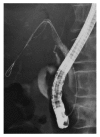Clinical utility of 0.025-inch guidewire VisiGlide2TM in the endoscopic retrograde cholangiopancreatography-related procedures
- PMID: 28250900
- PMCID: PMC5311476
- DOI: 10.4253/wjge.v9.i2.77
Clinical utility of 0.025-inch guidewire VisiGlide2TM in the endoscopic retrograde cholangiopancreatography-related procedures
Abstract
Aim: To examine the result of the use of 0.025-inch guidewire (GW) VisiGlide2TM as the first choice in the endoscopic retrograde cholangiopancreatography (ERCP)-related procedures without selecting the patient in a multicenter prospective study.
Methods: ERCP using 0.025-inch GW VisiGlide2TM as the first choice was conducted in patients who have needed ERCP, and its accomplishment rate of procedure, procedural time, incidence of accidental symptoms were compared with those of ERCP using 0.025-inch GW VisiGlideTM.
Results: The accomplishment rate of procedure was 97.5% (197/202), and procedural time was 23.930 ± 16.207 min. The accomplishment rate of procedure using 0.025-inch GW VisiGlideTM was 92.3% (183/195), and procedural time was 31.285 ± 19.122 min, thus the accomplishment rate of procedure was significantly improved and procedural time was significantly shortened (P < 0.05). Accidental symptoms by ERCP-related procedures were observed in 3.0% (6/202), and all were conservatively alleviated.
Conclusion: When 0.025-inch GW VisiGlide2TM was used for ERCP-related procedure as the first choice, it showed high accomplishment rate of procedure and low incidence of accidental symptoms, suggesting it can be used as the universal GW. Clinical Trial Registry (UMIN0000016042).
Keywords: 0.025-inch guidewire; Endoscopic retrograde cholangiopancreatography; Endoscopic sphincterotomy.
Conflict of interest statement
Conflict-of-interest statement: The authors have no other disclosures.
Figures





References
-
- Nambu T, Ukita T, Shigoka H, Omuta S, Maetani I. Wire-guided selective cannulation of the bile duct with a sphincterotome: a prospective randomized comparative study with the standard method. Scand J Gastroenterol. 2011;46:109–115. - PubMed
-
- Herreros de Tejada A, Calleja JL, Díaz G, Pertejo V, Espinel J, Cacho G, Jiménez J, Millán I, García F, Abreu L. Double-guidewire technique for difficult bile duct cannulation: a multicenter randomized, controlled trial. Gastrointest Endosc. 2009;70:700–709. - PubMed
-
- Angsuwatcharakon P, Rerknimitr R, Ridtitid W, Ponauthai Y, Kullavanijaya P. Success rate and cannulation time between precut sphincterotomy and double-guidewire technique in truly difficult biliary cannulation. J Gastroenterol Hepatol. 2012;27:356–361. - PubMed
-
- Osanai M, Maguchi H, Takahashi K, Katanuma A, Yane K, Kaneko M, Hashigo S, Katoh S, Harada R, Katoh R, et al. Safety and long-term outcomes of endoscopic papillary balloon dilation in children with bile duct stones. Gastrointest Endosc. 2011;73:619–623. - PubMed
LinkOut - more resources
Full Text Sources
Other Literature Sources

